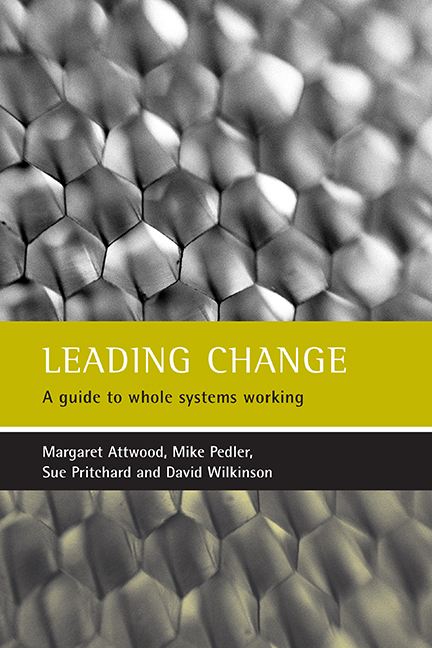Book contents
- Frontmatter
- Contents
- Foreword
- Foreword
- Prologue
- one Why do we need whole systems change?
- Two How Do We Put These Fine Words Intoaction? An Overview of Whole Systems Development
- Three The emerging practice of wholesystems development
- Four Leadership: keeping the big picture in view
- Five Public learning
- Six Valuing difference and diversity: getting the whole systeminto the room
- Seven Meeting differently: large and small group working
- Eight Follow-through and sticking with it
- Nine From organisations to networks
- Ten Confirming cases: local problems andlocal solutions within whole systems
- Epilogue
- Bibliography
- Index
Seven - Meeting differently: large and small group working
Published online by Cambridge University Press: 20 January 2022
- Frontmatter
- Contents
- Foreword
- Foreword
- Prologue
- one Why do we need whole systems change?
- Two How Do We Put These Fine Words Intoaction? An Overview of Whole Systems Development
- Three The emerging practice of wholesystems development
- Four Leadership: keeping the big picture in view
- Five Public learning
- Six Valuing difference and diversity: getting the whole systeminto the room
- Seven Meeting differently: large and small group working
- Eight Follow-through and sticking with it
- Nine From organisations to networks
- Ten Confirming cases: local problems andlocal solutions within whole systems
- Epilogue
- Bibliography
- Index
Summary
Question: How do you eat an elephant?
Answer: In bite-sized chunks!
At the heart of this old analogy for managing big changes lies a fallacy: that splitting a whole into parts makes the change process easier.
Consider a visual image of the elephant:
Each person sees only that part of the elephant on which they are focusing – a leg or a tusk. The whole animal is not visible. The challenge of designing whole systems development processes is to enable everyone to see the whole elephant together. Although in most cases this is an impossible aspiration, the key issue is to develop ways in which the actors can see, understand and think through their ways of working together on issues that cross organisational and community boundaries.
In this chapter we:
•examine the ways in which groups – both large and small – can meet differently to enable the principles of whole systems development to be practised;
• explore the leadership, design and logistics of big events as one key mechanism for meeting differently;
• discuss the consultancy support needed to assist these ways of working;
• encourage you to reflect and learn from personal experiences of meeting differently;
• explore the notion of ‘everyone in the room together’ as a metaphor for meeting differently as practised particularly through processes of action learning.
Drawing the boundaries for ‘meeting differently’
The more we engage in systems thinking, the more arbitrary formal organisationsseem:
• Why aren’t students seen as part of a school’s organisation?
• Or tenants, part of a housing department?
• Or customers and suppliers, part of a manufacturing company?
None of these can exist in isolation from the others. But so frequently, as with the internal departments of an organisation, formal boundaries quickly become walls and those beyond them adversaries. Ironically, these divisions have oftenbeen established to manage past changes, but then themselves have become barriers to progress. And traditional boundaries can so easily change – as therecent fashion for outsourcing has shown. In so many instances, what is technically inside an organisation and what is outside is relatively arbitrary.
From this perspective, it is artificial and unhelpful to design processes thatare confined within the ‘walls’ of a single department or organisation or, indeed,at parts of the wider systems of which organisations are but one part.
- Type
- Chapter
- Information
- Leading ChangeA Guide to Whole Systems Working, pp. 111 - 130Publisher: Bristol University PressPrint publication year: 2003



